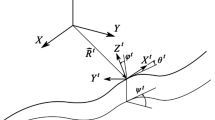Abstract
This paper describes a new numerical procedure for the modelling and simulation of the wheel–rail contact in railway dynamic simulations. The method is called knife-edge-equivalent contact constraint method, or simply KEC-method. Using this method, the wheel–rail contact is modelled as rigid or constraint-based using a set of kinematic constraints that eliminates one-degree of freedom of relative wheel–rail motion. The KEC-method uses a transformed but equivalent wheel profile in contact with a single-point rail. This equivalent profile has the property of producing the same wheelset-rail relative kinematics as the real wheel–rail profiles. The method can be used efficiently online while achieving better computational times than using contact lookup tables. Compared with existing constraint methods, the KEC-method has the following advantages: (1) simplification of the wheel–rail contact constraints, (2) simplified wheel–rail profiles, (3) online solution of the contact constraints, (4) reduction of the number of surface parameters, and (5) increased computational efficiency. A comparative study with respect to the use of efficient contact lookup tables in the simulation of Metro de Sevilla (metropolitan train in the city of Sevilla) shows that this contact method is appropriate to simulate the dynamics of a railway vehicle efficiently.



















Similar content being viewed by others
References
Shabana, A.A., Zaazaa, K.E., Sugiyama, H.: Railroad Vehicle Dynamics: A Computational Approach. CRC Press, Boca Raton (2007)
Shabana, A.A., Tobaa, M., Sugiyama, H., Zaazaa, K.E.: On the computer formulations of the wheel/rail contact problem. Nonlinear Dyn. 40(2), 169–193 (2005). https://doi.org/10.1007/s11071-005-5200-y
Shabana, A.A., Sany, J.R.: An augmented formulation for mechanical systems with non-generalized coordinates: application to rigid body contact problems. Nonlinear Dyn. 24(2), 183–204 (2001). https://doi.org/10.1023/A:1008362309558
Shabana, A.A., Zaazaa, K.E., Escalona, J.L., Sany, J.R.: Development of elastic force model for wheel/rail contact problems. J. Sound Vib. 269(1–2), 295–325 (2004). https://doi.org/10.1016/S0022-460X(03)00074-9
Escalona, J.L., Aceituno, J.F.: Multibody simulation of railway vehicles with contact lookup tables. Int. J. Mech. Sci. (2019). https://doi.org/10.1016/j.ijmecsci.2018.01.020
Pombo, J.C., Ambrósio, J.A.: Application of a wheel–rail contact model to railway dynamics in small radius curved tracks. Multibody Syst. Dyn. 19(1–2), 91–114 (2008). https://doi.org/10.1007/s11044-007-9094-y
Malvezzi, M., Meli, E., Falomi, S., Rindi, A.: Determination of wheel–rail contact points with semianalytic methods. Multibody Syst. Dyn. 20(4), 327–358 (2008). https://doi.org/10.1007/s11044-008-9123-5
Recuero, A.M., Aceituno, J.F., Escalona, J.L., Shabana, A.A.: A nonlinear approach for modeling rail flexibility using the absolute nodal coordinate formulation. Nonlinear Dyn. 83(1–2), 463–481 (2016). https://doi.org/10.1007/s11071-015-2341-5
Baeza, L., Thompson, D.J., Squicciarini, G., Denia, F.D.: Method for obtaining the wheel–rail contact location and its application to the normal problem calculation through ‘contact’. Veh. Syst. Dyn. (2018). https://doi.org/10.1080/00423114.2018.1439178
Sugiyama, H., Araki, K., Suda, Y.: On-line and off-line wheel/rail contact algorithm in the analysis of multibody railroad vehicle systems. J. Mech. Sci. Technol. 23(4), 991–996 (2009). https://doi.org/10.1007/s12206-009-0327-2
Santamaría, J., Vadillo, E., Gómez, J.: A comprehensive method for the elastic calculation of the two-point wheel–rail contact. Veh. Syst. Dyn. 44(suppl. 1), 240–250 (2006). https://doi.org/10.1080/00423110600870337
Schupp, G.: Bifurcation analysis of railway vehicles. Multibody Syst. Dyn. 15, 25–50 (2006). https://doi.org/10.1007/s11044-006-2360-6
Shabana, A.A., Tobaa, M., Marquis, B., El-Sibaie, M.: Effect of the linearization of the kinematic equations in railroad vehicle system dynamics. J. Comput. Nonlinear Dyn. 1(1), 25–34 (2005). https://doi.org/10.1115/1.1951783
Zhai, W., Sun, X.: A detailed model for investigating vertical interaction between railway vehicle and track. Veh. Syst. Dyn. 23(S1), 603–615 (1994). https://doi.org/10.1080/00423119308969544
Fisette, P., Samin, J.-C.: Lateral dynamics of a light railway vehicle with independent wheels. Veh. Syst. Dyn. 20(supl. 1), 157–171 (1992). https://doi.org/10.1080/00423119208969395
Montenegro, P., Neves, S., Calçada, R., Tanabe, M., Sogabe, M.: Wheel–rail contact formulation for analyzing the lateral train–structure dynamic interaction. Comput. Struct. 152, 200–214 (2015). https://doi.org/10.1016/j.compstruc.2015.01.004
Muñoz, S., Aceituno, J.F., Urda, P., Escalona, J.L.: Multibody model of railway vehicles with weakly coupled vertical and lateral dynamics. Mech. Syst. Signal Process. 115, 570–592 (2019). https://doi.org/10.1016/j.ymssp.2018.06.019
Arnold, M., Netter, H.: Wear profiles and the dynamical simulation of wheel-rail systems. In: Progress in Industrial Mathematics at ECMI, vol. 96, pp. 77–84. Springer, Berlin (1997). https://doi.org/10.1007/978-3-322-96688-9_8
Schupp, G., Weidemann, C., Mauer, L.: Modelling the contact between wheel and rail within multibody system simulation. Veh. Syst. Dyn. 41(5), 349–364 (2004). https://doi.org/10.1080/00423110412331300326
Netter, H., Schupp, G., Rulka, W., Schroeder, K.: New aspects of contact modelling and validation within multibody system simulation of railway vehicles. Veh. Syst. Dyn. 29(S1), 246–269 (1998). https://doi.org/10.1080/00423119808969563
Aceituno, J.F., Chamorro, R., García-Vallejo, D., Escalona, J.L.: On the design of a scaled railroad vehicle for the validation of computational models. Mech. Mach. Theory 115, 60–76 (2017). https://doi.org/10.1016/j.mechmachtheory.2017.04.015
Marino, F., Distante, A., Mazzeo, P.L., Stella, E.: A real-time visual inspection system for railway maintenance: automatic hexagonal-headed bolts detection. IEEE Trans. Syst. Man Cybern., Part C, Appl. Rev. 37(3), 418–428 (2007). https://doi.org/10.1109/TSMCC.2007.893278
Perrin, G., Soize, C., Duhamel, D., Funfschilling, C.: Track irregularities stochastic modeling. Probab. Eng. Mech. 34, 123–130 (2013). https://doi.org/10.1016/j.probengmech.2013.08.006
Wickens, A.: Fundamentals of Rail Vehicle Dynamics. Guidance and Stability. CRC Press, Boca Raton (2005)
Esveld, C.: Modern Railway Track. MRT-Productions, Zaltbommel (2001)
Polach, O.: Creep forces in simulations of traction vehicles running on adhesion limits. Wear 258, 992–1000 (2005). https://doi.org/10.1016/j.wear.2004.03.046
Claus, H., Schiehlen, W.: Modeling and simulation of railway bogie structural vibrations. Veh. Syst. Dyn. 29(S1), 538–552 (1998). https://doi.org/10.1080/00423119808969585
Acknowledgements
The first and third authors thank the Spanish Ministry of Science, Innovation and Universities under project reference TRA2017-86355-C2-1-R. The second author thanks for the support given by the Spanish Ministry of Science, Innovation and Universities under the Mobility Program ‘José Castillejo’ with reference CAS18/00072. All this support is gratefully acknowledged.
Author information
Authors and Affiliations
Corresponding author
Ethics declarations
Conflicts of interest
The authors declare that there is no conflict of interest to this work.
Additional information
Publisher’s Note
Springer Nature remains neutral with regard to jurisdictional claims in published maps and institutional affiliations.
Rights and permissions
About this article
Cite this article
Escalona, J.L., Aceituno, J.F., Urda, P. et al. Railway multibody simulation with the knife-edge-equivalent wheel–rail constraint equations. Multibody Syst Dyn 48, 373–402 (2020). https://doi.org/10.1007/s11044-019-09708-x
Received:
Accepted:
Published:
Issue Date:
DOI: https://doi.org/10.1007/s11044-019-09708-x




